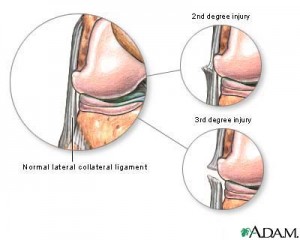The lateral collateral ligament is the main supporting structure on the outside of the knee. It provides stability to the joint when the knee is pushed outward. A lateral collateral ligament (LCL) injury is usually a mild problem. There are three degrees of ligament injuries. A first-degree injury consists of only mild stretching of the ligament. There is no looseness. A second-degree LCL is a partial tear of the ligament. In a third-degree injury, the ligament is completely ruptured, and the joint is unstable.
A force applied to the inside of the knee causes this type of injury. This most often happens while playing sports. An LCL injury can also be caused by overuse of the joint, and by falls in an elderly individual.

Many LCL injuries cannot be prevented. However, to lessen the risk of injury, a person should be in good physical shape before engaging in sporting activities. Sports safety guidelines should be followed for adults, adolescents and children. Proper stretching exercises should be done prior to athletic activity.
The treatment for LCL injuries depends on the severity of the problem. The kind of activities a person is likely to do in the future is also taken into account. RICE, which stands for rest, ice, compression with an ace bandage, and elevation of the leg, is the standard initial treatment. Medicine, such as nonsteroidal anti-inflammatory drugs (NSAIDs), can be used for pain. Crutches can be helpful until motion and strength in the joint have improved. Occasionally, a brace is used for a few days to immobilize the knee.
The person also needs to do knee exercises to regain flexibility in the joint and strength in the thigh muscle. Physical therapy is sometimes needed to help with this. The individual should also take care to avoid reinjuring the joint before it has completely healed. Surgery may be needed in severe cases where the ligament has been torn and the knee is unstable.
© 2021 Singapore Orthopaedic Centre for Spine & Sports Medicine. All Rights Reserved.
Designed By ArsEmporium.com
Connect with Us




